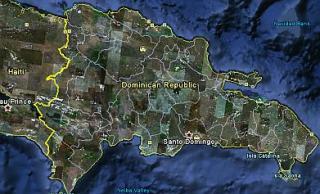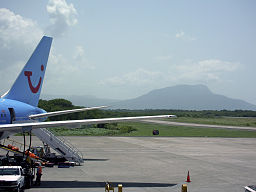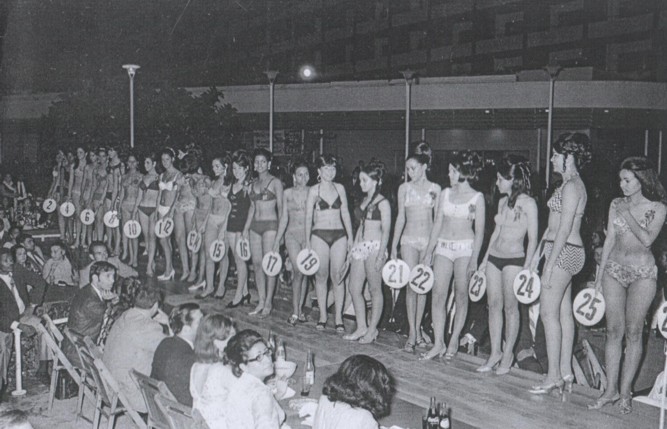
Exploring the history and experiences of mixed heritage persons and inter-racial relationships across the world

Exploring the history and experiences of mixed heritage persons and inter-racial relationships across the world
 With 73% of the population self-identifying as of mixed heritage, the Dominican Republic probably has the highest concentration of mixed heritage people in the world. This is in sharp contrast to the rest of the West Indies where people of mostly slave descent are more likely to identify as black including the other country that shares the Hispaniola Island with the Dominican Republic, Haiti. It is actually difficult to explore Dominican history without including Haiti. In fact, the island was on several occasions in history a single country and on one of those occasion governed by the Haitians under the rule of, interestingly enough, a free gens de couleur (mixed race) offspring of a French colonialist and a former Guinea slave, Jean-Pierre Boyer in 1822.
With 73% of the population self-identifying as of mixed heritage, the Dominican Republic probably has the highest concentration of mixed heritage people in the world. This is in sharp contrast to the rest of the West Indies where people of mostly slave descent are more likely to identify as black including the other country that shares the Hispaniola Island with the Dominican Republic, Haiti. It is actually difficult to explore Dominican history without including Haiti. In fact, the island was on several occasions in history a single country and on one of those occasion governed by the Haitians under the rule of, interestingly enough, a free gens de couleur (mixed race) offspring of a French colonialist and a former Guinea slave, Jean-Pierre Boyer in 1822.
The rivalry between the two countries stretches back into colonial history with the Spanish controlling the Dominican Republic and France being the final colonialists of the Haitian side. The island was ‘discovered’ by Christopher Columbus on his first New world voyages in 1492 and after one of his ships ran aground, he was allowed to leave 39 men in a new settlement at the site in Haiti. On his second journey a year later, Columbus found his first settlement destroyed and all the members killed by the natives who took violent exception to being mistreated. On this second journey, he set up the settlement of La Isabela in present day Dominican Republic which is considered the first formal European settlement in the New World. Of interest, it has been recently revealed that 7 of original settlers men were of African descent thus being the first Africans to arrive in the Americas, some 150 years earlier than the first slaves.

The French came to control the whole island in 1795 as a result of the French Revolutionary Wars. Revolting slaves captured Santo Domingo in 1801 and thus controlled the entire island until in 1802 Napoleon sent a French army to recapture the island. The slaves and yellow fever kept the French out of Haiti and in 1804 the ex-slaves declared it independent as the Republic of Haiti, making it was the first independent nation in Latin America and the first black-led republic in the world. The resultant massive multiracial exodus of French colonialists, creoles and their slaves from Haiti led indirectly (via Cuba) to the strengthening of the creole culture in New Orleans in the USA.
In 1808, when Napoleon invaded Spain, the Dominicans revolted against French rule and, with the help of Spain’s ally, Great Britain, and oddly enough Haiti, returned it to Spanish control. After some years, the Dominican born Spaniards known as the criollos declared the Dominican Republic independent in 1821 but the independent Haitians wishing to defend itself against re-colonisation by the Spanish or the French and led by Jean-Pierre Boyer invaded and took control for the next 20 years. The fear that Boyer had of re-colonisation led to him making an agreement with the French which haunts Haiti to this day, ensuring the continued poverty of its people. In return for 150 million francs, the price of ‘lost profits’ and later reduced to 90 million, the French agreed to recognise Haiti as an independent state. Boyer had to borrow the first instalment of 30 million francs from France.
Dominican historians claim that the Haitian occupation was cruel and barbarous but Boyer did free the slaves and nationalised the land which with other measures were so unpopular that both Dominicans and Haitians plotted his overthrow.
 After the war of independence from Haiti, there followed a period of great uncertainty with the country reverting back to a Spanish colony – mainly to avoid further Haitian incursions, of which there were several, and an attempt to have the country annexed by the United States which was supported by two US Presidents. Annexation meant a naval base and a place to resettle newly freed slaves from the US but President Grant’s proposal was closely defeated in the US Senate. The US did eventually occupy the country after a period of great instability and to protect the Panama Canal route from 1916 to 1924. The Americans would return again later.
After the war of independence from Haiti, there followed a period of great uncertainty with the country reverting back to a Spanish colony – mainly to avoid further Haitian incursions, of which there were several, and an attempt to have the country annexed by the United States which was supported by two US Presidents. Annexation meant a naval base and a place to resettle newly freed slaves from the US but President Grant’s proposal was closely defeated in the US Senate. The US did eventually occupy the country after a period of great instability and to protect the Panama Canal route from 1916 to 1924. The Americans would return again later.
It is debateable whether the Haitian’s invasion attempts and Boyer’s rule are the source of the racism that led to a uniquely Dominican policy of racial discrimination called Antihaitianismo (anti-Haitianism) which is still so prevalent in Dominican society that in 2007, the United Nations found racism against blacks in general, and Haitians in particular, to be very evident. The formalisation of the anti- Haitianism may be blamed on President Rafael Trujillo who ruled from 1930 until his assassination in 1961. In 1937, accusing Haiti and Haitians in the borderlands of various crimes including harbouring his political opponents, Trujillo, despite being quarter Haitian himself, ordered his soldiers to interrogate anyone with dark skin, using the shibboleth perejil (parsley) to identify Haitians and kill them. It is said that machetes were used so that the massacre could not be traced back to the soldiers leading to between 20,000 and 30,000 Haitians being killed including those trying to escape back to Haiti. It is questionable whether Trujillo wanted a war so he could control the whole island but the Haitian government were subdued and did not retaliate militarily.
The justification of Antihaitianismo is very hard to understand considering that the racial mix of the mixed Dominican citizen is European and African (mulatto) with a notable amount of Taíno ancestry. Trujillo used the Spanish European mix to justify the racism against the ‘black slaves’. He was so set on lightening the Dominicans that he had an open door policy on immigration with a heavy bias to accepting non-black immigrants accepting potentially 100,000 Jewish refugees from Europe, Japanese migration during the 1930s, and exiles from Spain following its civil war. Haitian immigrants on the other hand are denied Dominican nationality and are often denied services as they are deemed to be transient residents.
 The Americans returned to control the country in April, 1965, some troublous years after Trujillo’s assassination, when U.S. president Lyndon Johnson, concerned over the possible takeover by communists sent in the Marines. The US remained until they had supervised elections in 1966. During this period, many Dominicans took advantage of the easing of travel restrictions, obtained visas and immigrated to the United States setting up networks that assisted further immigration even after the Americans left. The Dominican diaspora in the USA is the 5th largest Hispanic population which numbered some 1.3 million people in 2006. Of interest is the fact that in the 1990 US census where Hispanic citizens were asked to classify their race, 29% of Dominican Americans claimed to be white, 30% claimed black and a mere 40% other race (mixed) in the census which contrasts with the ethnic composition of the Republic’s population which is 73% multiracial, 16% white, and 11% black.
The Americans returned to control the country in April, 1965, some troublous years after Trujillo’s assassination, when U.S. president Lyndon Johnson, concerned over the possible takeover by communists sent in the Marines. The US remained until they had supervised elections in 1966. During this period, many Dominicans took advantage of the easing of travel restrictions, obtained visas and immigrated to the United States setting up networks that assisted further immigration even after the Americans left. The Dominican diaspora in the USA is the 5th largest Hispanic population which numbered some 1.3 million people in 2006. Of interest is the fact that in the 1990 US census where Hispanic citizens were asked to classify their race, 29% of Dominican Americans claimed to be white, 30% claimed black and a mere 40% other race (mixed) in the census which contrasts with the ethnic composition of the Republic’s population which is 73% multiracial, 16% white, and 11% black.
The Dominicans, despite the fact their country has nearly the largest economy in Central America and the Caribbean and is relatively rich for Latin America, seek new pastures in Puerto Rico and the USA. Many Dominicans wishing to immigrate to the US use the neighbouring island of Puerto Rico as a stepping stone. In increasing cases, they are immigrating illegally in dangerous vessels over the strait to Puerto Rico. In contrast to Dominican immigrants in the 1970s who were thought to be mainly professionals and managers, current immigrants work in skilled occupations and as unskilled and low-paid workers. Wages for these groups tend to be higher than back in the Republic. They are also well represented as small business owners.
Mirroring the Haitians back home, Dominican immigrants are easy victims for ethnic discrimination and are often targets of racism in Puerto Rico but despite this, inter-marriage is fairly high. Puerto Rico is an unincorporated territory of the United States and its citizens have been regarded as US citizens since 1917. In the 2000 US Census, 80% of Puerto Ricans self-identified as white, 6.9% black and 4.4% mixed. In 1858, mixed and white populations were equal in numbers with a smaller slave population. Genetically, a recent study points to over 50% processing Amerindian DNA.
Back in the Republic, in addition to the Haitians, there are descendants of predominantly black immigrants who came from other Caribbean islands such as St. Kitts and Nevis, Dominica, Antigua, St. Vincent, Martinique, and Guadeloupe. It is not clear whether these groups suffer racism as bad as the Haitians but they do suffer some. Even dark Dominicans attempt to use other words to describe their skin colour to separate them from the undesirable black label. These labels such as moreno/a (brown) and canelo/a (red/brown) are similar to those used by Brazilians. Other ethnic groups in the country include Middle Eastern Arabs and Jews and a significant presence of Chinese, said to number around 50,000, and Japanese. How much racial mixing between these groups is unknown and is probably still insignificant to register in statistics.
In most parts of the world, racism is being actively recognised and tackled. Mirroring the Brazilians, Dominicans like to say ‘no hay racism aqui’ (‘there is no racism here’) but it appears that this region of the Caribbean it is not being tackled to any great extent. In terms of growing mixed people in this region, it will be Puerto Rican (white) and Dominicans (mixed blacks) in Puerto Rico leading the way. It will be interesting to see how the offspring of these mixed relationships end up getting treated in Puerto Rican society, I suspect they will be happily accepted in the Dominican one. As for mixing in Haitian society, it is likely that it will be those who leave the island that are most likely to end up in mixed relationships.
Links